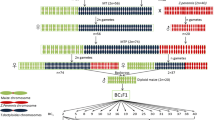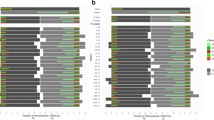Abstract
Polyploid plants in the genus Tripsacum, a wild relative of maize, reproduce through gametophytic apomixis of the diplosporous type, an asexual mode of reproduction through seed. Moving gene(s) responsible for the apomictic trait into crop plants would open new areas in plant breeding and agriculture. Efforts to transfer apomixis from Tripsacum into maize at CIMMYT resulted in numerou intergeneric F1 hybrids obtained from various Tripsacum species. A bulk-segregant analysis was carried out to identify molecular markers linked to diplospory in T. dactyloides. This was possible because of numerous genome similarities among related species in the Andropogoneae. On the basis of maize RFLP probes, three restriction fragments co-segregating with diplospory were identified in one maize-Tripsacum dactyloides F1 population that segregated 1∶1 for the mode of reproduction. The markers were also found to be linked in the maize RFLP map, on the distal end of the long arm of chromosome 6. These results support a simple inheritance of diplospory in Tripsacum. Manipulation of the mode of reproduction in maize-Tripsacum backcross generations, and implications for the transfer of apomixis into maize, are discussed.
Similar content being viewed by others
References
Ahn S, Anderson JA, Sorrells ME, Tanksley SD (1993) Homoeologous relationships of rice, wheat and maize chromosomes. Mol Gen Genet 241:483–490
Asker S, Jerling L (1992) Apomixis in plants. CRC Press, Boca Raton
Bashaw EC (1980) Apomixis and its implication in crop improvement. In: Fehr WR, Hadley HH (eds) Hybridization of crop plants. American Society of Agronomy, Madison, Wisconsin, pp 45–63
Beckett JB (1978) B-A translocations in maize. J Hered 69:27–36
Bennetzen JL, Freeling M (1993) Grasses as a single genetic system: genome composition, collinearity and compatibility. Trends Genet 9:259–261
Brown WV, Emery HP (1958) Apomixis in the Gramineae: Panicoideae. Am J Bot 45:253–263
Burr B, Burr F, Thompson KA, Albertson MC, Stubber CW (1988) Gene mapping with recombinant inbreds in maize. Genetics 118:519–526
Burua UM, Chalmers KJ, Hackett CA, Thomas WTB, Powell W, Waugh R (1993) Identification of RAPD markers linked to a Rhynchosporium secalis resistance locus in barley using nearisogenic lines and bulked-segregant analysis. Heredity 71: 177–184
Crane CF, Carman JG (1987) Mechanisms of apomixis in Elymus rectisetus from Eastern Australia and New Zealand. Am J Bot 74:477–496
Dumas C, Mogensen HL (1993) Gametes and fertilization: maize as a model system for experimental embryogenesis in flowering plants. The Plant Cell 5:1337–1348
Faure JE, Digonnet C, Dumas C (1994) An in vitro system for adhesion and fusion of maize gametes. Science 263:1598–1600
Galinat WC (1971) The origin of maize. Annu Rev Gen 5:447–478
Gardiner JM, Coe EH, Melia-Hancock S, Hoisington DA, Chao S (1993) Development of a core RFLP map in maize using an immortalized F2 population. Genetics 134:917–930
Grivet L, D'Hont A, Dufour P, Hamon P, Roques D, Glazmann JC (1994) Comparative mapping of sugarcane with other species within the Andropogoneae tribe. Heredity 73:500–508
Harlan JR, de Wet JMJ (1977) Pathways of genetic transfer from Tripsacum to Zea mays. Proc Natl Acad Sci USA 74:3494–3497
Helentjaris T, Slocum M, Wright S, Schaefer A, Nienhuis J (1986) Construction of genetic linkage maps in maize and tomato using restriction fragment length polymorphisms. Theor Appl Genet 72:761–769
Hoisington D, Khairallah M, González-de-León D (1994) Laboratory protocols, 2nd edn. CIMMYT Applied Molecular Genetics Laboratory. CIMMYT, México D.F
Hulbert SH, Richter TE, Axtell JD, Bennentzen JL (1990) Genetic mapping and characterization of sorghum and related crops by means of maize DNA probes. Proc Natl Acad Sci USA 87: 4251–4255
Jefferson RA (1994) Apomixis: a social revolution for agriculture? The Monitor 19:14–16
Kindiger B, Beckett JB (1990) Cytological evidence supporting a procedure for directing and enhancing pairing between maize and Tripsacum. Genome 33:495–500
Kojima A, Kozono T, Nagato Y, Hinata K (1994) Non-parthenogenetic plants detected in Chinese chive, a facultative apomict. Breeding Sci 44:143–149
Leblanc O, Peel MD, Carman JG, Savidan Y (1995) Megasporogenesis and megagametogenesis in several Tripsacum species (Poaceae). Am J Bot 82 (in press)
Liu CJ, Atkinson MD, Chinoy CN, Devos KM, Gale MD (1992) Nonhomoeologous translocations between group 4,5, and 7 chromosomes within wheat and rye. Theor Appl Genet 83:305–312
Melake Berhan A, Hulbert SH, Butler LG, Bennetzen JL (1993) Structure and evolution of the genomes of Sorghum bicolor and Zea mays. Theor Appl Genet 86:598–604
Michelmore RW, Paran I, Kesseli RV (1991) Identification of markers linked to disease-resistance genes by bulked-segregant analysis: a rapid method to detect markers in specific genome regions by using segregating populations. Proc Natl Acad Sci USA 88:9828–9832
Mogie M (1988) A model for the evolution and control of generative apomixis. Biol J Linn Soc 35:127–153
Mohan M, Nair S, Bentur JS, Rao UP, Bennett J (1994) RFLP and RAPD mapping of the rice Gm2 gene that confers resistance to biotype 1 of the gall midge (Orseolia oryzae). Theor Appl Genet 87:782–788
Nogler GA (1984a) Gametophytic apomixis. In: Johri BM (ed) Embryology of angiosperms. Springer-Verlag, Berlin
Nogler GA (1984b) Genetics of apospory in apomictic Ranunculus auricomus. V. Conclusion. Bot Helv 94:411–422
Ozias-Akins P, Lubbers EL, Hanna WW, McNay JW (1993) Transmission of the apomictic mode of reproduction in Pennisetum: co-inheritance of the trait and molecular markers. Theor Appl Genet 85:632–638
Peel MD (1993) Meiocyte callose in aposporic and diplosporic grasses and in hybrids between bread wheat and Elymus rectisetus. MS thesis Utah State University
Penner GA, Chong J, Lévesque-Lemay M, Molnar SJ, Fedak G (1993) Identification of a RAPD marker linked to the oat stemrust gene Pg3. Theor Appl Genet 85:702–705
Pineda O, Bonierbale MW, Plaisted RL, Brodie BB, Tanksley SD (1993) Identification of RFLP markers linked to the the H1 gene conferring the resistance to the potato cyst nematode Globodera rostochiensis. Genome 36:152–156
Renner O (1916) Zur Terminologie des pflanzlichen Generationswechsels. Biol Zentralbl 36:337–374
Savidan Y (1982) Nature et hérédité de l'apomixie chez Panicum maximum Jacq. PhD thesis Université of Paris XI
Savidan Y, Dujardin M (1992) Apomixie: la prochaine révolution verte? La Recherche 241:326–334
Sherwood RT, Berg CC, Young BA (1994) Inheritance of apospory in buffalograss. Crop Sci 34:1490–1494
Stuber CW, Wendel JF, Goodman MM, Smith JCS (1988) Techniques and scoring procedures for starch-gel electrophoresis of enzymes from maize (Zea mays L.). North Carolina State Experiment Station Technical Bulletin 286.
Valle CB do, Miles JW (1994) Melhoramento de gramineas do genero Brachiaria. In: Simposio sobre manejo pastagens, 11. Fundacao de Estudos Agrarios Luiz de Queiroz, Piracicaba
Author information
Authors and Affiliations
Additional information
Communicated by G. S. Khush
Rights and permissions
About this article
Cite this article
Leblanc, O., Grimanelli, D., González-de-León, D. et al. Detection of the apomictic mode of reproduction in maize-Tripsacum hybrids using maize RFLP markers. Theoret. Appl. Genetics 90, 1198–1203 (1995). https://doi.org/10.1007/BF00222943
Received:
Accepted:
Issue Date:
DOI: https://doi.org/10.1007/BF00222943




